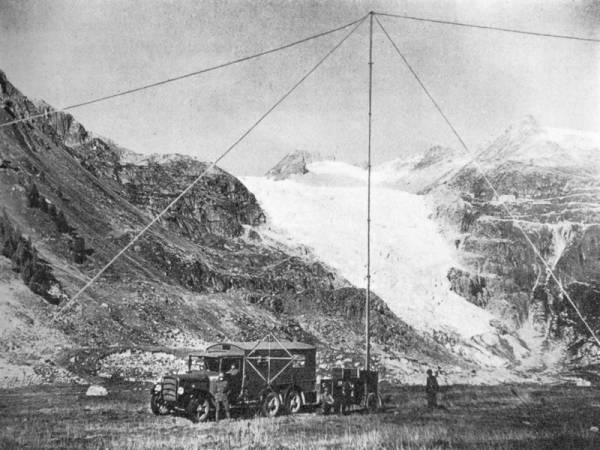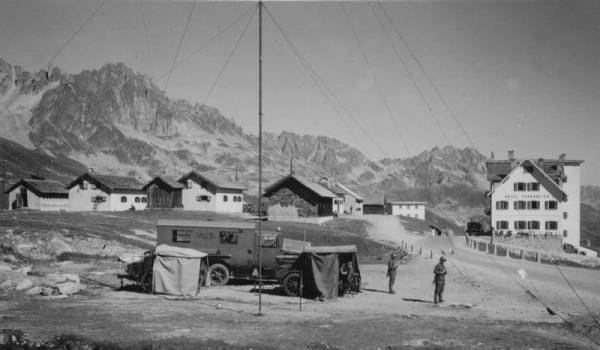Inhaltsverzeichnis
SE-216: S.M. / Schwere Motorfunkenstation
Schwere Motorfunkenstation („Heavy motorized wireless station“), S.M.; made by Telefunken, Zurich.
The „Schwere Motorfunkenstation“ S.M. was developed at Telefunken Berlin in 1923/24. The equipment was technically identical to that of the Fahrbare Schwere Funkstation F.S., which was installed on a three axle truck FBW towing a trailer with the transmitter mast.
Technical Specifications
- Principle: wireless station with separate transmitter and receiver
- Frequency Range: 100 - 860 kHz
Configuration 1929
- Transmitter Spez 219Bs (Telefunken): 99 - 857 kHz
Configuration 1933
- Transmitter Spez 219Bs (Telefunken): 99 - 857 kHz
Power Supply
- Generator: Siemens generator (100 V, 500 Hz, 20A and 50V, 12 A) driven from a petrol engine.
Dimensions
- the station material has a weight of 785 kg, the complete station with the FBW truck 8600 kg
Accessories
Station Material
All equipment of the „Fahrbar Schwere Funkstation F.S.“ were developed by the Telefunken GmbH, Berlin, in around 1923/4. When installed on a three-axle truck FBW, the station got the designation „Schwere Motorfunkenstation“ / S.M., a total of four stations were acquired.
Inside the station truck, the components of the transmitter can be found on the left side. To the right, the receiver Spez 7Bs (E25) with the attached LF amplifier is located.
The Telefunken transmitter Spez 219Bs is tunable from 350 - 3025 m (99 - 857 kHz). The transmitter uses the valves RS55, two RS19 and a rectifier RG64. The station has a maximum output power of 200 W in CW (A1) and 70 watts in modulated telegraphy and telephony (A2, A3), the rectified 500 Hz alternating current from the generator is used to generate the 1000 Hz audio frequency for modulated telegraphy.
Initially, a Telefunken receiver Spez 7Bs (receiver E25) (two RE 062t) with a separate two-stage AF amplifier Spez 60Bs was used. In 1933 it was replaced by the Telefunken long wave receiver Spez 470Bs / E31, the three tuned circuit TRF receiver covers a frequency range of 100 - 1091 kHz in four ranges and is equipped with six valves RE074n.
Technical Principle
Tube Layout
c.f componente
Development
The equipment of the „Fahrbar Schwere Funkstation F.S.“ was developed by Telefunken GmbH, Berlin, around 1923/4 and was very similar to the „heavy motor vehicle radio station“ of the German Reichswehr.
The „auto-motive“ station with the three-axle FBW truck (8600 kg) and the attached mast trailer (1400 kg) was also similar to the „heavy motor vehicle radio station“ of the German Reichswehr and was mainly used in mountain areas, where after tests with the prototypes of the technically similar „Fahrbar Schwere Funkstation F.S.“ turned out, that this configuration was unsuitable in difficult terrain.
Field use

In 1929 four „Schwere Motorfunkenstation“ trucks were acquired. The material was already relatively outdated, when it was handed over to the Signals Kp 5 in 1937, during the „active service“ in World War II, the station was no longer used motorized on the truck.
All equipment was removed from the trucks and converted into 17 payloads. After troop order 51, this station got the designation SE-216 and was allocated to Landsturm Signal Kp 57/58 until it's liquidation in 1960.
The three-axle FBW trucks found a second use in 1943, when the Motorized Military Police Battalion was created as radio vehicle. After troop order 51, one of the radio trucks served the signal schools as a mobile interception station vehicle.









